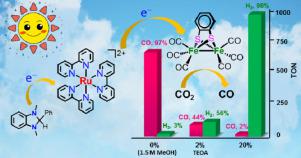当前位置:
X-MOL 学术
›
Chin. J. Catal.
›
论文详情
Our official English website, www.x-mol.net, welcomes your
feedback! (Note: you will need to create a separate account there.)
Selective photocatalytic reduction of CO2 to CO mediated by a [FeFe]-hydrogenase model with a 1,2-phenylene S-to-S bridge
Chinese Journal of Catalysis ( IF 15.7 ) Pub Date : 2021-02-01 , DOI: 10.1016/s1872-2067(20)63644-0 Minglun Cheng , Xiongfei Zhang , Yong Zhu , Mei Wang
Chinese Journal of Catalysis ( IF 15.7 ) Pub Date : 2021-02-01 , DOI: 10.1016/s1872-2067(20)63644-0 Minglun Cheng , Xiongfei Zhang , Yong Zhu , Mei Wang

|
Abstract Photocatalytic reduction of CO2 to CO is a promising approach for storing solar energy in chemicals and mitigating the greenhouse effect of CO2. Our recent studies revealed that [(μ-bdt)Fe2(CO)6] (1, bdt = benzene-1,2-dithiolato), a [FeFe]-hydrogenase model with a rigid and conjugate S-to-S bridge, was catalytically active for the selective photochemical reduction of CO2 to CO, while its analogous complex [(μ-edt)Fe2(CO)6] (2, edt = ethane-1,2-dithiolato) was inactive. In this study, it was found that the turnover number of 1 for CO evolution reached 710 for the 1/[Ru(bpy)3]2+/BIH (BIH = 1,3-dimethyl-2-phenyl-2,3-dihydro-1H-benzo[d]-imidazole) system under optimal conditions over 4.5 h of visible-light irradiation, with a turnover frequency of 7.12 min−1 in the first hour, a high selectivity of 97% for CO, and an internal quantum yield of 2.8%. Interestingly, the catalytic selectivity of 1 can be adjusted and even completely switched in a facile manner between the photochemical reductions of CO2 to CO and of protons to H2 simply by adding different amounts of triethanolamine to the catalytic system. The electron transfer in the photocatalytic system was studied by steady-state fluorescence and transient absorption spectroscopy, and a plausible mechanism for the photocatalytic reaction was proposed.
中文翻译:

由具有 1,2-亚苯基 S-to-S 桥的 [FeFe]-氢化酶模型介导的 CO2 选择性光催化还原为 CO
摘要 将 CO2 光催化还原为 CO 是一种将太阳能储存在化学品中并减轻 CO2 温室效应的有前景的方法。我们最近的研究表明 [(μ-bdt)Fe2(CO)6] (1, bdt = benzo-1,2-dithiolato),一种具有刚性和共轭 S-to-S 桥的 [FeFe]-氢化酶模型,对 CO2 选择性光化学还原为 CO 具有催化活性,而其类似的复合物 [(μ-edt)Fe2(CO)6] (2, edt = ethane-1,2-dithiolato) 是无活性的。在本研究中,发现对于 1/[Ru(bpy)3]2+/BIH (BIH = 1,3-二甲基-2-苯基-2,3- dihydro-1H-benzo[d]-imidazole) 系统在最佳条件下超过 4.5 小时的可见光照射,第一小时的周转频率为 7.12 min-1,对 CO 的选择性高达 97%,和2.8%的内部量子产率。有趣的是,只需向催化体系中加入不同量的三乙醇胺,就可以轻松地在 CO2 光化学还原为 CO 和质子光化学还原为 H2 之间调节甚至完全切换 1 的催化选择性。通过稳态荧光和瞬态吸收光谱研究了光催化体系中的电子转移,并提出了光催化反应的合理机制。
更新日期:2021-02-01
中文翻译:

由具有 1,2-亚苯基 S-to-S 桥的 [FeFe]-氢化酶模型介导的 CO2 选择性光催化还原为 CO
摘要 将 CO2 光催化还原为 CO 是一种将太阳能储存在化学品中并减轻 CO2 温室效应的有前景的方法。我们最近的研究表明 [(μ-bdt)Fe2(CO)6] (1, bdt = benzo-1,2-dithiolato),一种具有刚性和共轭 S-to-S 桥的 [FeFe]-氢化酶模型,对 CO2 选择性光化学还原为 CO 具有催化活性,而其类似的复合物 [(μ-edt)Fe2(CO)6] (2, edt = ethane-1,2-dithiolato) 是无活性的。在本研究中,发现对于 1/[Ru(bpy)3]2+/BIH (BIH = 1,3-二甲基-2-苯基-2,3- dihydro-1H-benzo[d]-imidazole) 系统在最佳条件下超过 4.5 小时的可见光照射,第一小时的周转频率为 7.12 min-1,对 CO 的选择性高达 97%,和2.8%的内部量子产率。有趣的是,只需向催化体系中加入不同量的三乙醇胺,就可以轻松地在 CO2 光化学还原为 CO 和质子光化学还原为 H2 之间调节甚至完全切换 1 的催化选择性。通过稳态荧光和瞬态吸收光谱研究了光催化体系中的电子转移,并提出了光催化反应的合理机制。









































 京公网安备 11010802027423号
京公网安备 11010802027423号